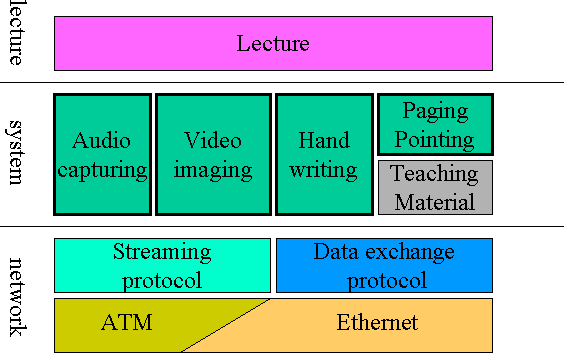
On supporting distance learning, remote students should receive both kinds of elements simultaneously. We should recognize what kind of presentation information arises in real-time in a classroom and send appropriate elements to the remote students because it is not only impractical for the lecturers to prepare all the presentation information in advance but also difficult to predict reaction of the students in the lecture. This point is different from producing CDROM or WWW for education provided by some universities.
One of the most important presentation information is considered to be a gesture of the lecturer and behavior of the students. Therefore, we concentrate on visual aspect of presentation information in this research.
We assume two kinds of objects to be visualized in a local classroom
in our distance learning framework. Those are the lecturer and
the students. They generate visual presentation information in the
lecture.
We explain how to shoot these objects and visualize them. We use
multiple active cameras for shooting in real-time. Description of
dynamic situation is introduced to determine appropriate camera
control and video selection.
The framework for supporting distance learning is described in
Section 2
and we propose an imaging method with
dynamic situation in
Section 3.
We show experimental results in
Section 4
and
conclude our paper in
Section 5.
Back to Table of Contents
In this paper, we consider a kind of distance learning in which there are two remote classrooms, one with a lecturer and students, and the other with only students. The lecturer uses WWW pages to present his/her teaching materials, and uses an electric whiteboard to draw subsidiary figures and diagrams during the lecture.
There is a layer structure in the distance learning system as is shown in Figure 1. The lowest layer is network layer. The network layer has to assure data transmission, particularly streaming audio/video data transmission.

|
|
|
Above the network layer, we have system layer in which video imaging system, audio recording system, hand-writing system, and teaching material handling system exist. The purpose of these four systems is to detect and capture presentation information. There are not only persons but also text/figures in a classroom to be imaged from a viewpoint of visualization. As we prepare the electric whiteboard which can record everything the lecturer writes on it during his/her lecture and WWW pages which can be displayed directly to the screen in the remote classroom, these objects are out of our focus on imaging the lecture in this research. Our framework of distance learning system is shown in Figure 2. The lecturer in the left classroom uses the electric whiteboard and WWW synchronization software on PC. Transmitted data of the electric whiteboard and WWW pages are displayed on one screen-T in the remote classroom. There is the other screen V which is used to display video of the lecturer and the students.
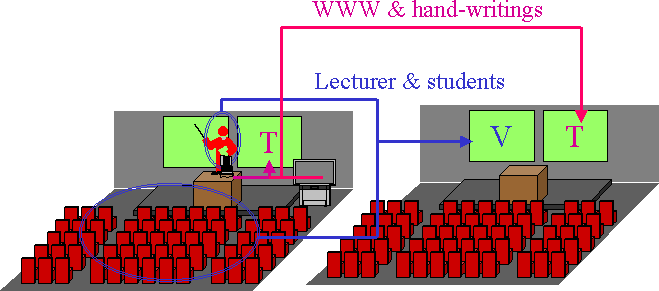
|
|
|
The second style is acceptable when the interests of the remote students take precedence over the context of the lecture. We have already proposed the imaging method for this style [2].
The third style is for an event which happens in the classroom but is not related to the lecture. As no one can predict such kind of unexpected event, there is no systematic imaging way against it. Therefore, we should model common reaction when people encounter the unexpected events.
We focus on the first style in this paper. Since gestures of the
lecturer and the behaviors of the students are very important
presentation information in the lecture, the following sections
describe our method for shooting them based on the situation of the
lecture.
Back to Section Top
Because this is based on a dynamic situation in the classroom at that time, then it should know: "2. What kind of dynamic situation is now ?"
The first question is linked to the second question through the dynamic situation [1]. See Figure 3.
A representation gap of the dynamic situation is an obstacle on interpreting dynamic situation between the two questions. As the first question should be answered from the viewpoint of capturing presentation information, it is preferable to describe the imaging rules symbolically. "Watch the lecturer closely when he/she is talking to the students" is an example where the main clause of the imaging rule is called camera-work and the subordinate clause which is called A-component is a symbolic representation which describes a part of the dynamic situation. The dynamic situation sometimes consists of several A-components during the lecture. A pair of the camera-work and the A-component represents one imaging rule, and several imaging rules which has the same A-component but different camera-works can be specified simultaneously.
The second question should be answered by computer vision technique. The system estimates certain values numerically such as the location of the objects in the classroom by the technique. We call these numerically estimated values situation features.
We introduce a mapping function which maps the situation features onto the A-components as shown in Figure 3. The system extracts the situation features in the classroom and detects several A-components which represents the current dynamic situation according to the mapping function, then controls an active camera to shoot the specified object.
The camera-work which is realized at the active camera consists of four elements as (object, object-location, camera-location, priority). It indicates that the object in the object-location should be shot by the shoot camera at the camera-location.
In the broadcast imaging style, the camera-works for answering the first question are given to the system in advance.
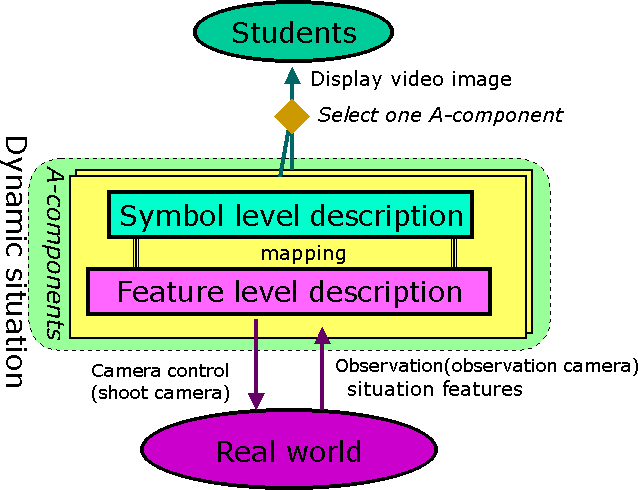
|
|
|
The region of the lecturer on the image plane of the observation camera is detected by checking motion region in the successive two video images. Then, the location of the lecturer is calculated with single camera by introducing the constraint that the lecturer always locates on a certain horizontal plane in the 3D world and by giving the camera parameters of location, direction, focal length, image aspect, and so on in advance. The location of the active students is also estimated by almost the same technique.
We use multiple observation cameras to cover almost all the area of
the classroom.
Back to Section Top
One of the reasons is that the lecturer may walk around in the classroom and the students in any seats may become active. In this case, the object to be shot may easily go out of the visible area of the static shoot camera. The other reason is that the lecturer may walk faster than the maximum speed of pan/tilt/zoom of the active camera. Therefore, the system should control multiple shoot cameras simultaneously.
When one A-component is detected and the corresponding camera-work
uses an active camera, the camera will follow the object as long as
the A-component is being detected.
Back to Section Top
Our video selection method consists of two rules. The first rule is processed based on the dynamic situation in the classroom. The second rule is based on human intrinsic feature.
Then, the shoot cameras that are assigned to the camera-works of the selected A-component become candidates to be used. Since there may be multiple camera-works (it means multiple cameras) for one A-component, we have to choose one of them under the time constraint we introduce here. There are two criteria for it; one is that a man/woman needs certain time to understand what he/she watches. Based on the criterion, we introduce "glance time" which limits the shortest time of keeping the video stream from a single camera. The other is that a person become bored if he/she watches the same object from the same camera location for a long time. To avoid this, we introduce "release time" which limits the longest time of keeping the video stream from the same camera.
Therefore, if there is a camera-work that lasts less than the glance
time, it is always adopted.
On the other hand, if there is no change of dynamic situation even
after the release time is over and if there are the other camera-works
corresponding to the same A-component, one camera-work among them is
newly selected.
Back to Section Top
Back to Table of Contents
We conducted an experiment on actual distance learning lectures which were held between Kyoto university and UCLA. The prepared A-components are as follows:
| A | The lecturer is pointing on the screen-T. |
| B1-3 | The lecturer is talking to the students. |
| C1-12 | Some of the students are active. |
B1-3 are the same A-component but are found on three different places. We divide audience area into 12 blocks so we need 12 A-components for Ci. As A, B1, B2 and B3 represent the lecturer and C1, ... , C12 represent the students, they may occur at the same time.
The set of imaging rules given to the system in advance is shown in Table 1, and the mapping function is shown in Figure 4. If a moving object is found in each area, the corresponding A-component is detected. We use three static shoot cameras in the imaging rules.
| A-Component | camera-work | |
|---|---|---|
| object | camera | |
| A | lecturer | 7 |
| A | screen-T | 5[fixed] |
| B1 | lecturer | 7 |
| B1 | lecturer | 4[fixed] |
| B2 | lecturer | 7 |
| B3 | lecturer | 7 |
| C1-12 | student(1-12) | 6[fixed] |
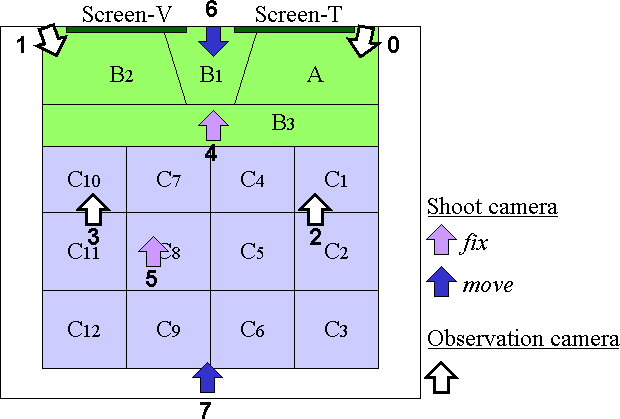
|
|
|
Figure 5 shows a sequence of generated lecture video transmitted to the remote classroom. Two kinds of arrows indicate video selection rule in the sequence.
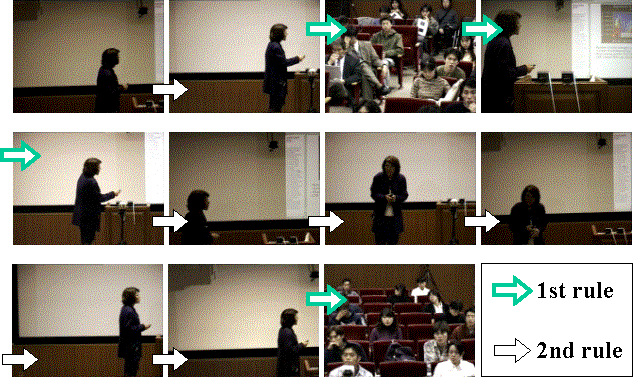
|
|
|
Some students in the remote classroom reported us that the video
imaging result contained the presentation information such as
behaviors of the lecturer and the students, and was suitable to the
lecture. It is considered that our experiment was successful on
capturing the visual presentation information through the
questionnaire survey we conducted against the remote students.
We are planning to add hyper-links onto the generated video from
the other information such as hand-writings recorded on the electric
whiteboard in the lecture.
Back to Table of Contents

